Australian Fast Food Market: Analysis Using Porter’s Five Forces
VerifiedAdded on 2023/06/08
|8
|1717
|438
Report
AI Summary
This report provides a market analysis of the fast food industry in Australia using Porter's Five Forces model. It identifies the fast food industry as a rapidly growing sector with a monopolistic market structure. The analysis covers entry barriers, bargaining power of suppliers and customers, the threat of substitutes, and competitive rivalry within the industry. Key findings suggest high entry barriers, low supplier bargaining power, high customer bargaining power, and a significant threat from substitutes like organic food. The report concludes with recommendations for firms to address health concerns, adapt to changing customer preferences, leverage entry barriers, and provide high-quality food at reasonable prices. The importance of supply chain management is also emphasized for sustained success in the Australian fast food market. Desklib offers a wide range of solved assignments and study resources for students.

Running head: FOOD MARKETING
FOOD MARKETING
FOOD MARKETING
Paraphrase This Document
Need a fresh take? Get an instant paraphrase of this document with our AI Paraphraser
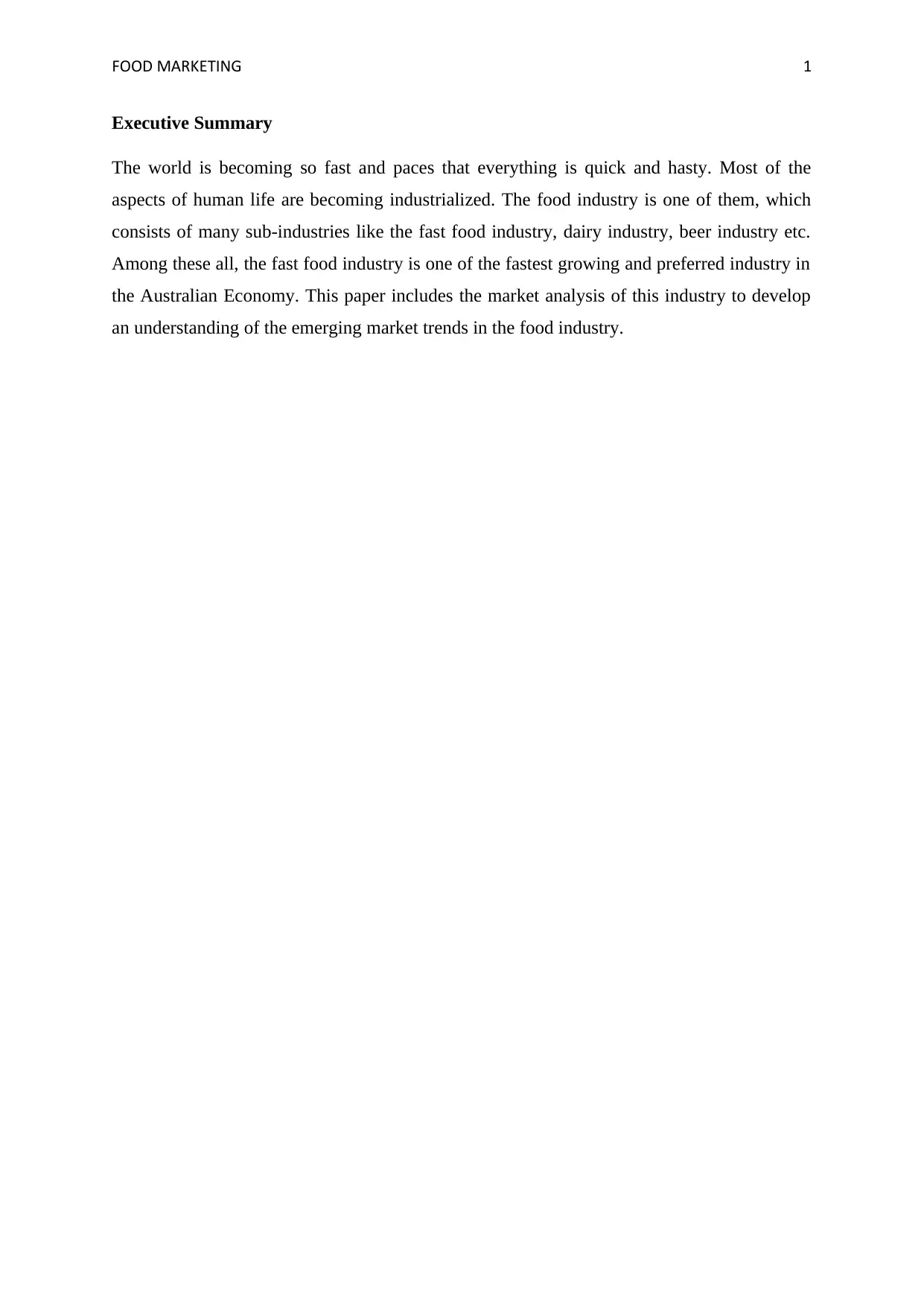
FOOD MARKETING 1
Executive Summary
The world is becoming so fast and paces that everything is quick and hasty. Most of the
aspects of human life are becoming industrialized. The food industry is one of them, which
consists of many sub-industries like the fast food industry, dairy industry, beer industry etc.
Among these all, the fast food industry is one of the fastest growing and preferred industry in
the Australian Economy. This paper includes the market analysis of this industry to develop
an understanding of the emerging market trends in the food industry.
Executive Summary
The world is becoming so fast and paces that everything is quick and hasty. Most of the
aspects of human life are becoming industrialized. The food industry is one of them, which
consists of many sub-industries like the fast food industry, dairy industry, beer industry etc.
Among these all, the fast food industry is one of the fastest growing and preferred industry in
the Australian Economy. This paper includes the market analysis of this industry to develop
an understanding of the emerging market trends in the food industry.
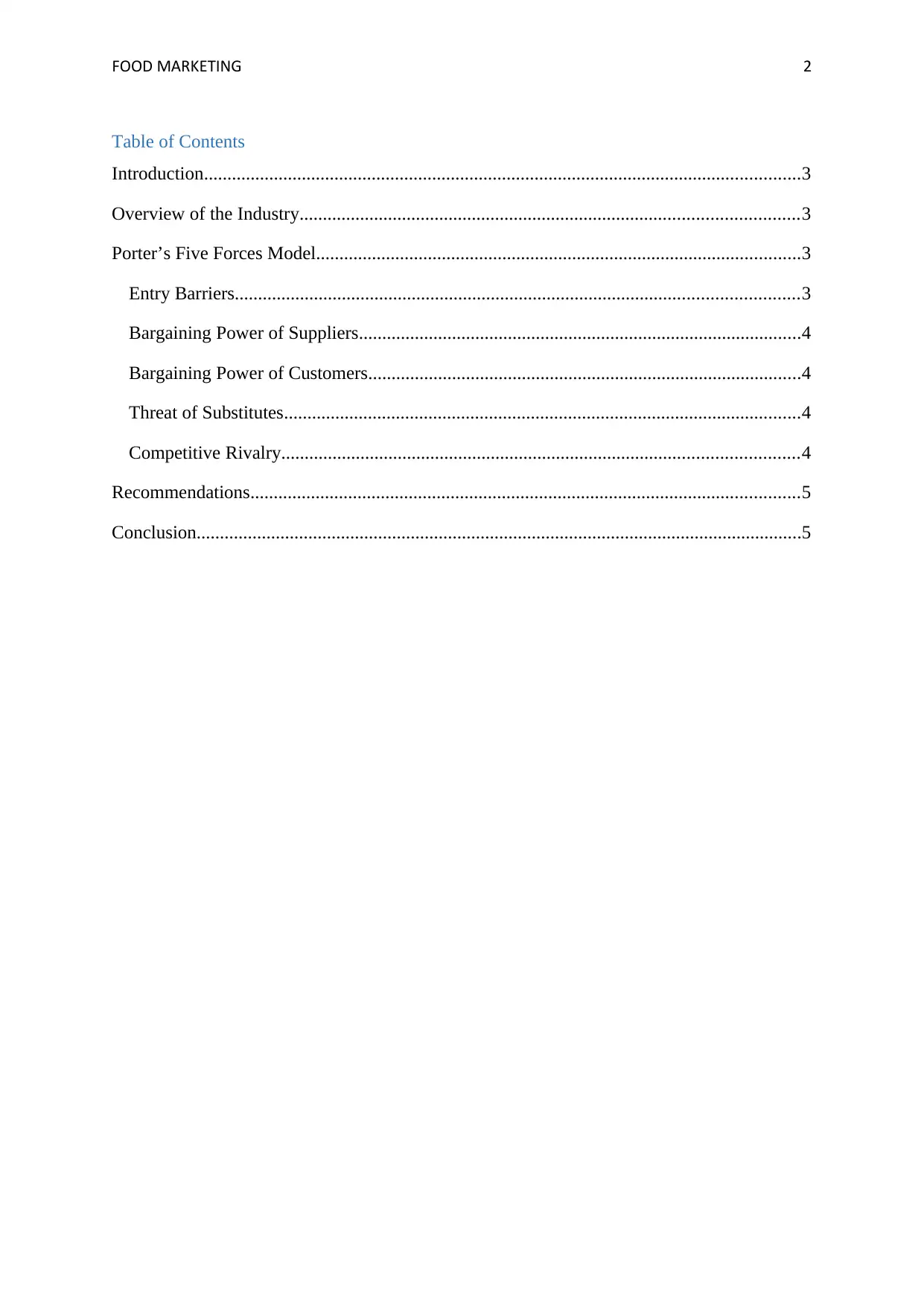
FOOD MARKETING 2
Table of Contents
Introduction................................................................................................................................3
Overview of the Industry...........................................................................................................3
Porter’s Five Forces Model........................................................................................................3
Entry Barriers.........................................................................................................................3
Bargaining Power of Suppliers...............................................................................................4
Bargaining Power of Customers.............................................................................................4
Threat of Substitutes...............................................................................................................4
Competitive Rivalry...............................................................................................................4
Recommendations......................................................................................................................5
Conclusion..................................................................................................................................5
Table of Contents
Introduction................................................................................................................................3
Overview of the Industry...........................................................................................................3
Porter’s Five Forces Model........................................................................................................3
Entry Barriers.........................................................................................................................3
Bargaining Power of Suppliers...............................................................................................4
Bargaining Power of Customers.............................................................................................4
Threat of Substitutes...............................................................................................................4
Competitive Rivalry...............................................................................................................4
Recommendations......................................................................................................................5
Conclusion..................................................................................................................................5
⊘ This is a preview!⊘
Do you want full access?
Subscribe today to unlock all pages.

Trusted by 1+ million students worldwide
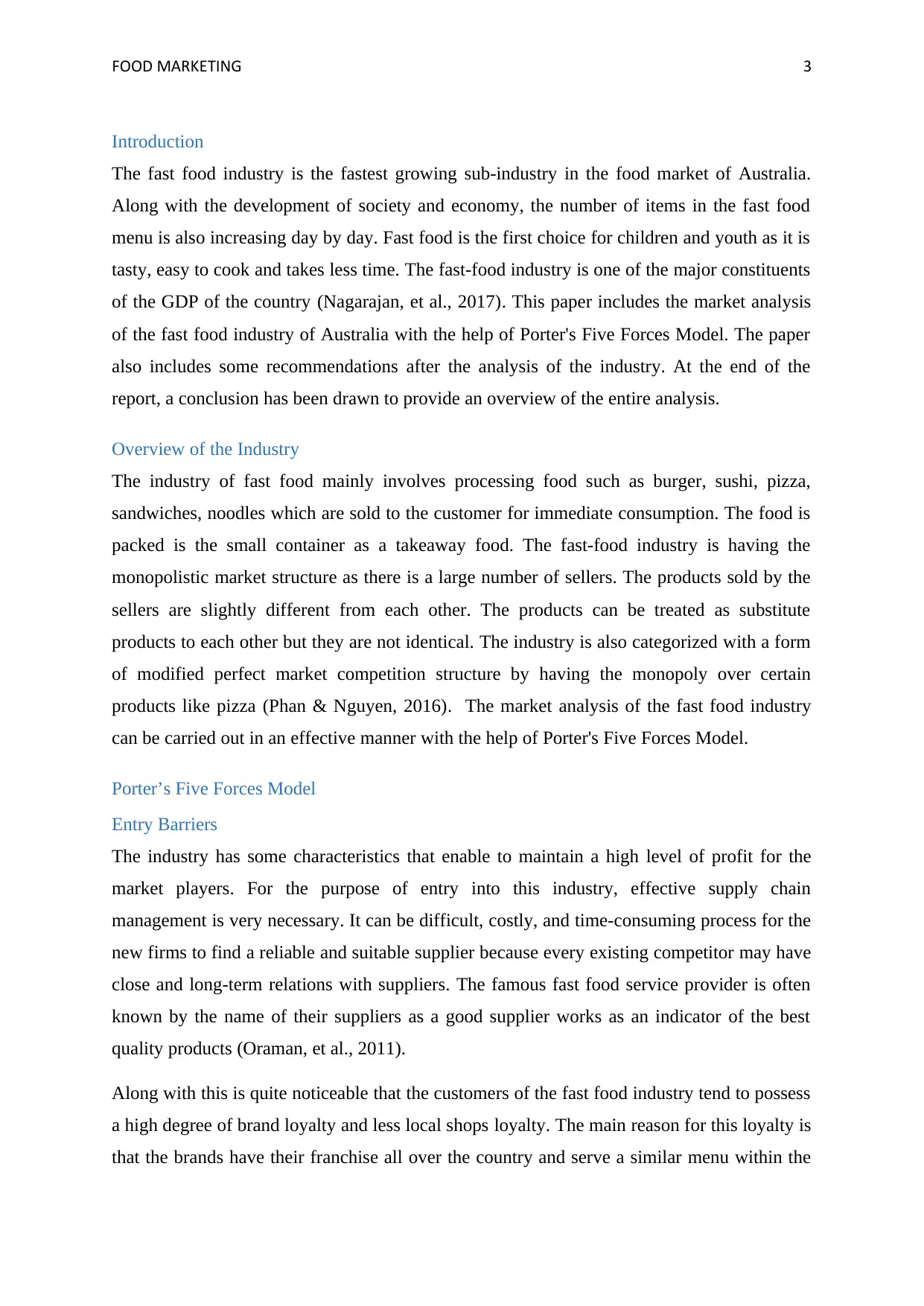
FOOD MARKETING 3
Introduction
The fast food industry is the fastest growing sub-industry in the food market of Australia.
Along with the development of society and economy, the number of items in the fast food
menu is also increasing day by day. Fast food is the first choice for children and youth as it is
tasty, easy to cook and takes less time. The fast-food industry is one of the major constituents
of the GDP of the country (Nagarajan, et al., 2017). This paper includes the market analysis
of the fast food industry of Australia with the help of Porter's Five Forces Model. The paper
also includes some recommendations after the analysis of the industry. At the end of the
report, a conclusion has been drawn to provide an overview of the entire analysis.
Overview of the Industry
The industry of fast food mainly involves processing food such as burger, sushi, pizza,
sandwiches, noodles which are sold to the customer for immediate consumption. The food is
packed is the small container as a takeaway food. The fast-food industry is having the
monopolistic market structure as there is a large number of sellers. The products sold by the
sellers are slightly different from each other. The products can be treated as substitute
products to each other but they are not identical. The industry is also categorized with a form
of modified perfect market competition structure by having the monopoly over certain
products like pizza (Phan & Nguyen, 2016). The market analysis of the fast food industry
can be carried out in an effective manner with the help of Porter's Five Forces Model.
Porter’s Five Forces Model
Entry Barriers
The industry has some characteristics that enable to maintain a high level of profit for the
market players. For the purpose of entry into this industry, effective supply chain
management is very necessary. It can be difficult, costly, and time-consuming process for the
new firms to find a reliable and suitable supplier because every existing competitor may have
close and long-term relations with suppliers. The famous fast food service provider is often
known by the name of their suppliers as a good supplier works as an indicator of the best
quality products (Oraman, et al., 2011).
Along with this is quite noticeable that the customers of the fast food industry tend to possess
a high degree of brand loyalty and less local shops loyalty. The main reason for this loyalty is
that the brands have their franchise all over the country and serve a similar menu within the
Introduction
The fast food industry is the fastest growing sub-industry in the food market of Australia.
Along with the development of society and economy, the number of items in the fast food
menu is also increasing day by day. Fast food is the first choice for children and youth as it is
tasty, easy to cook and takes less time. The fast-food industry is one of the major constituents
of the GDP of the country (Nagarajan, et al., 2017). This paper includes the market analysis
of the fast food industry of Australia with the help of Porter's Five Forces Model. The paper
also includes some recommendations after the analysis of the industry. At the end of the
report, a conclusion has been drawn to provide an overview of the entire analysis.
Overview of the Industry
The industry of fast food mainly involves processing food such as burger, sushi, pizza,
sandwiches, noodles which are sold to the customer for immediate consumption. The food is
packed is the small container as a takeaway food. The fast-food industry is having the
monopolistic market structure as there is a large number of sellers. The products sold by the
sellers are slightly different from each other. The products can be treated as substitute
products to each other but they are not identical. The industry is also categorized with a form
of modified perfect market competition structure by having the monopoly over certain
products like pizza (Phan & Nguyen, 2016). The market analysis of the fast food industry
can be carried out in an effective manner with the help of Porter's Five Forces Model.
Porter’s Five Forces Model
Entry Barriers
The industry has some characteristics that enable to maintain a high level of profit for the
market players. For the purpose of entry into this industry, effective supply chain
management is very necessary. It can be difficult, costly, and time-consuming process for the
new firms to find a reliable and suitable supplier because every existing competitor may have
close and long-term relations with suppliers. The famous fast food service provider is often
known by the name of their suppliers as a good supplier works as an indicator of the best
quality products (Oraman, et al., 2011).
Along with this is quite noticeable that the customers of the fast food industry tend to possess
a high degree of brand loyalty and less local shops loyalty. The main reason for this loyalty is
that the brands have their franchise all over the country and serve a similar menu within the
Paraphrase This Document
Need a fresh take? Get an instant paraphrase of this document with our AI Paraphraser
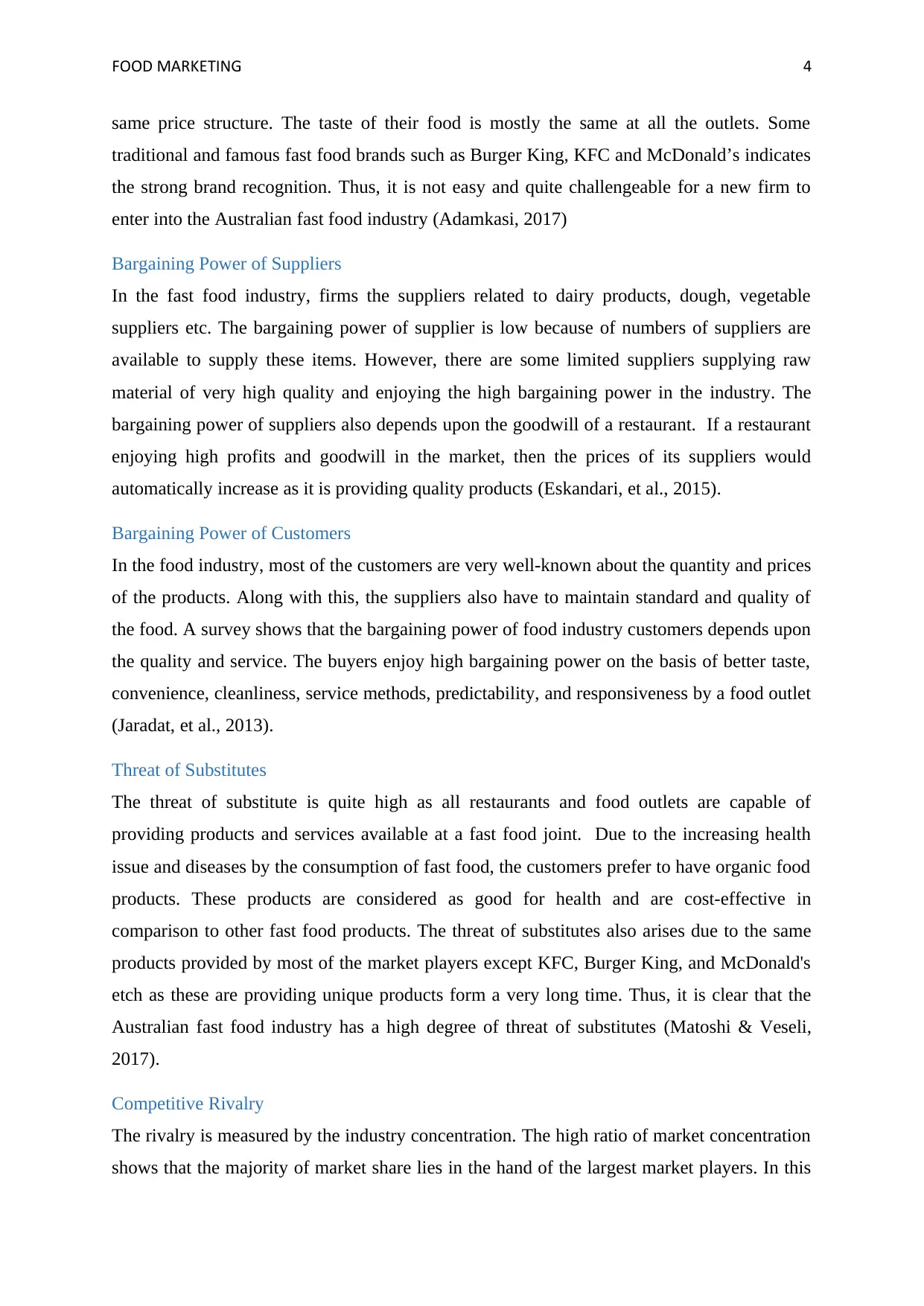
FOOD MARKETING 4
same price structure. The taste of their food is mostly the same at all the outlets. Some
traditional and famous fast food brands such as Burger King, KFC and McDonald’s indicates
the strong brand recognition. Thus, it is not easy and quite challengeable for a new firm to
enter into the Australian fast food industry (Adamkasi, 2017)
Bargaining Power of Suppliers
In the fast food industry, firms the suppliers related to dairy products, dough, vegetable
suppliers etc. The bargaining power of supplier is low because of numbers of suppliers are
available to supply these items. However, there are some limited suppliers supplying raw
material of very high quality and enjoying the high bargaining power in the industry. The
bargaining power of suppliers also depends upon the goodwill of a restaurant. If a restaurant
enjoying high profits and goodwill in the market, then the prices of its suppliers would
automatically increase as it is providing quality products (Eskandari, et al., 2015).
Bargaining Power of Customers
In the food industry, most of the customers are very well-known about the quantity and prices
of the products. Along with this, the suppliers also have to maintain standard and quality of
the food. A survey shows that the bargaining power of food industry customers depends upon
the quality and service. The buyers enjoy high bargaining power on the basis of better taste,
convenience, cleanliness, service methods, predictability, and responsiveness by a food outlet
(Jaradat, et al., 2013).
Threat of Substitutes
The threat of substitute is quite high as all restaurants and food outlets are capable of
providing products and services available at a fast food joint. Due to the increasing health
issue and diseases by the consumption of fast food, the customers prefer to have organic food
products. These products are considered as good for health and are cost-effective in
comparison to other fast food products. The threat of substitutes also arises due to the same
products provided by most of the market players except KFC, Burger King, and McDonald's
etch as these are providing unique products form a very long time. Thus, it is clear that the
Australian fast food industry has a high degree of threat of substitutes (Matoshi & Veseli,
2017).
Competitive Rivalry
The rivalry is measured by the industry concentration. The high ratio of market concentration
shows that the majority of market share lies in the hand of the largest market players. In this
same price structure. The taste of their food is mostly the same at all the outlets. Some
traditional and famous fast food brands such as Burger King, KFC and McDonald’s indicates
the strong brand recognition. Thus, it is not easy and quite challengeable for a new firm to
enter into the Australian fast food industry (Adamkasi, 2017)
Bargaining Power of Suppliers
In the fast food industry, firms the suppliers related to dairy products, dough, vegetable
suppliers etc. The bargaining power of supplier is low because of numbers of suppliers are
available to supply these items. However, there are some limited suppliers supplying raw
material of very high quality and enjoying the high bargaining power in the industry. The
bargaining power of suppliers also depends upon the goodwill of a restaurant. If a restaurant
enjoying high profits and goodwill in the market, then the prices of its suppliers would
automatically increase as it is providing quality products (Eskandari, et al., 2015).
Bargaining Power of Customers
In the food industry, most of the customers are very well-known about the quantity and prices
of the products. Along with this, the suppliers also have to maintain standard and quality of
the food. A survey shows that the bargaining power of food industry customers depends upon
the quality and service. The buyers enjoy high bargaining power on the basis of better taste,
convenience, cleanliness, service methods, predictability, and responsiveness by a food outlet
(Jaradat, et al., 2013).
Threat of Substitutes
The threat of substitute is quite high as all restaurants and food outlets are capable of
providing products and services available at a fast food joint. Due to the increasing health
issue and diseases by the consumption of fast food, the customers prefer to have organic food
products. These products are considered as good for health and are cost-effective in
comparison to other fast food products. The threat of substitutes also arises due to the same
products provided by most of the market players except KFC, Burger King, and McDonald's
etch as these are providing unique products form a very long time. Thus, it is clear that the
Australian fast food industry has a high degree of threat of substitutes (Matoshi & Veseli,
2017).
Competitive Rivalry
The rivalry is measured by the industry concentration. The high ratio of market concentration
shows that the majority of market share lies in the hand of the largest market players. In this
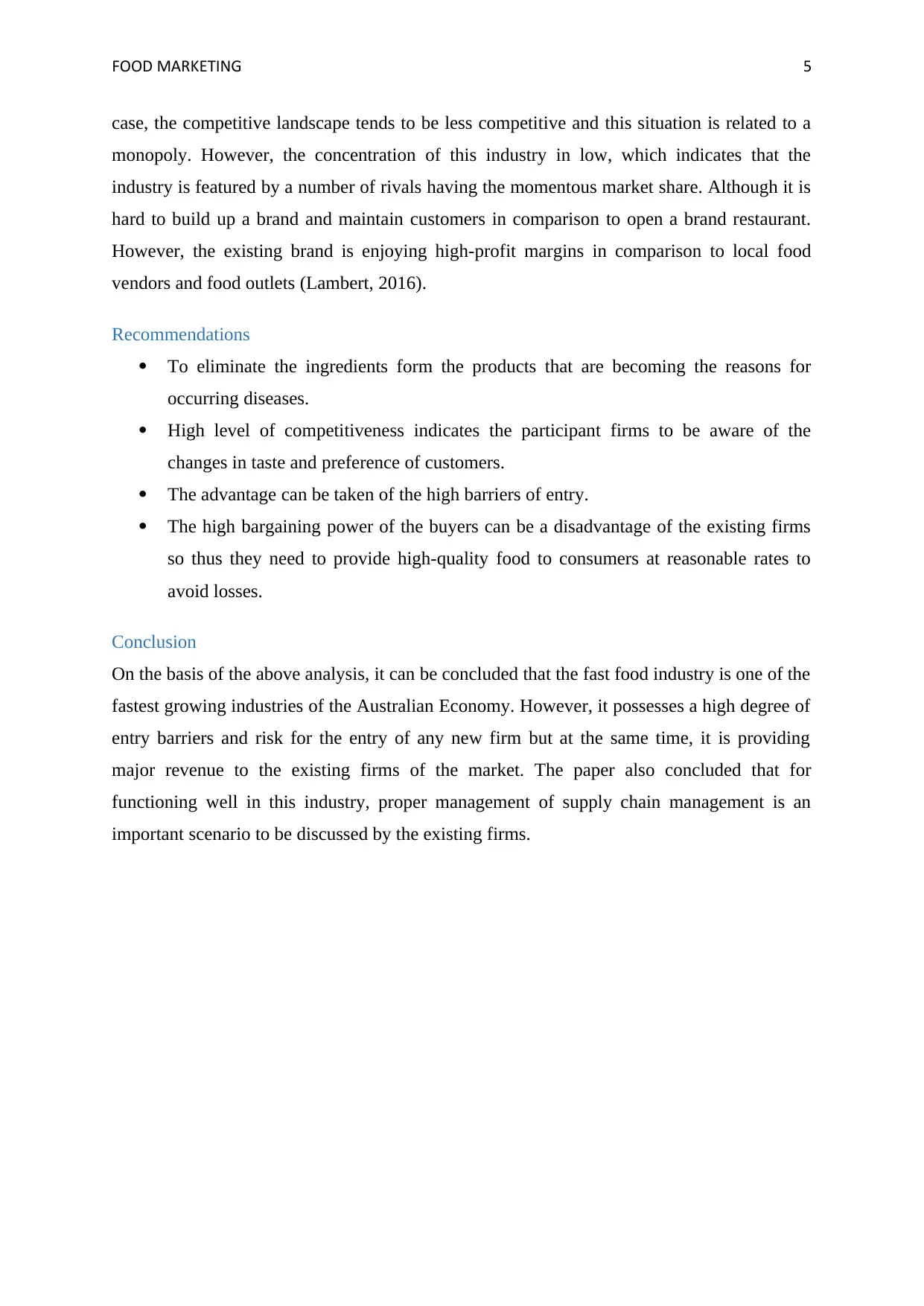
FOOD MARKETING 5
case, the competitive landscape tends to be less competitive and this situation is related to a
monopoly. However, the concentration of this industry in low, which indicates that the
industry is featured by a number of rivals having the momentous market share. Although it is
hard to build up a brand and maintain customers in comparison to open a brand restaurant.
However, the existing brand is enjoying high-profit margins in comparison to local food
vendors and food outlets (Lambert, 2016).
Recommendations
To eliminate the ingredients form the products that are becoming the reasons for
occurring diseases.
High level of competitiveness indicates the participant firms to be aware of the
changes in taste and preference of customers.
The advantage can be taken of the high barriers of entry.
The high bargaining power of the buyers can be a disadvantage of the existing firms
so thus they need to provide high-quality food to consumers at reasonable rates to
avoid losses.
Conclusion
On the basis of the above analysis, it can be concluded that the fast food industry is one of the
fastest growing industries of the Australian Economy. However, it possesses a high degree of
entry barriers and risk for the entry of any new firm but at the same time, it is providing
major revenue to the existing firms of the market. The paper also concluded that for
functioning well in this industry, proper management of supply chain management is an
important scenario to be discussed by the existing firms.
case, the competitive landscape tends to be less competitive and this situation is related to a
monopoly. However, the concentration of this industry in low, which indicates that the
industry is featured by a number of rivals having the momentous market share. Although it is
hard to build up a brand and maintain customers in comparison to open a brand restaurant.
However, the existing brand is enjoying high-profit margins in comparison to local food
vendors and food outlets (Lambert, 2016).
Recommendations
To eliminate the ingredients form the products that are becoming the reasons for
occurring diseases.
High level of competitiveness indicates the participant firms to be aware of the
changes in taste and preference of customers.
The advantage can be taken of the high barriers of entry.
The high bargaining power of the buyers can be a disadvantage of the existing firms
so thus they need to provide high-quality food to consumers at reasonable rates to
avoid losses.
Conclusion
On the basis of the above analysis, it can be concluded that the fast food industry is one of the
fastest growing industries of the Australian Economy. However, it possesses a high degree of
entry barriers and risk for the entry of any new firm but at the same time, it is providing
major revenue to the existing firms of the market. The paper also concluded that for
functioning well in this industry, proper management of supply chain management is an
important scenario to be discussed by the existing firms.
⊘ This is a preview!⊘
Do you want full access?
Subscribe today to unlock all pages.

Trusted by 1+ million students worldwide
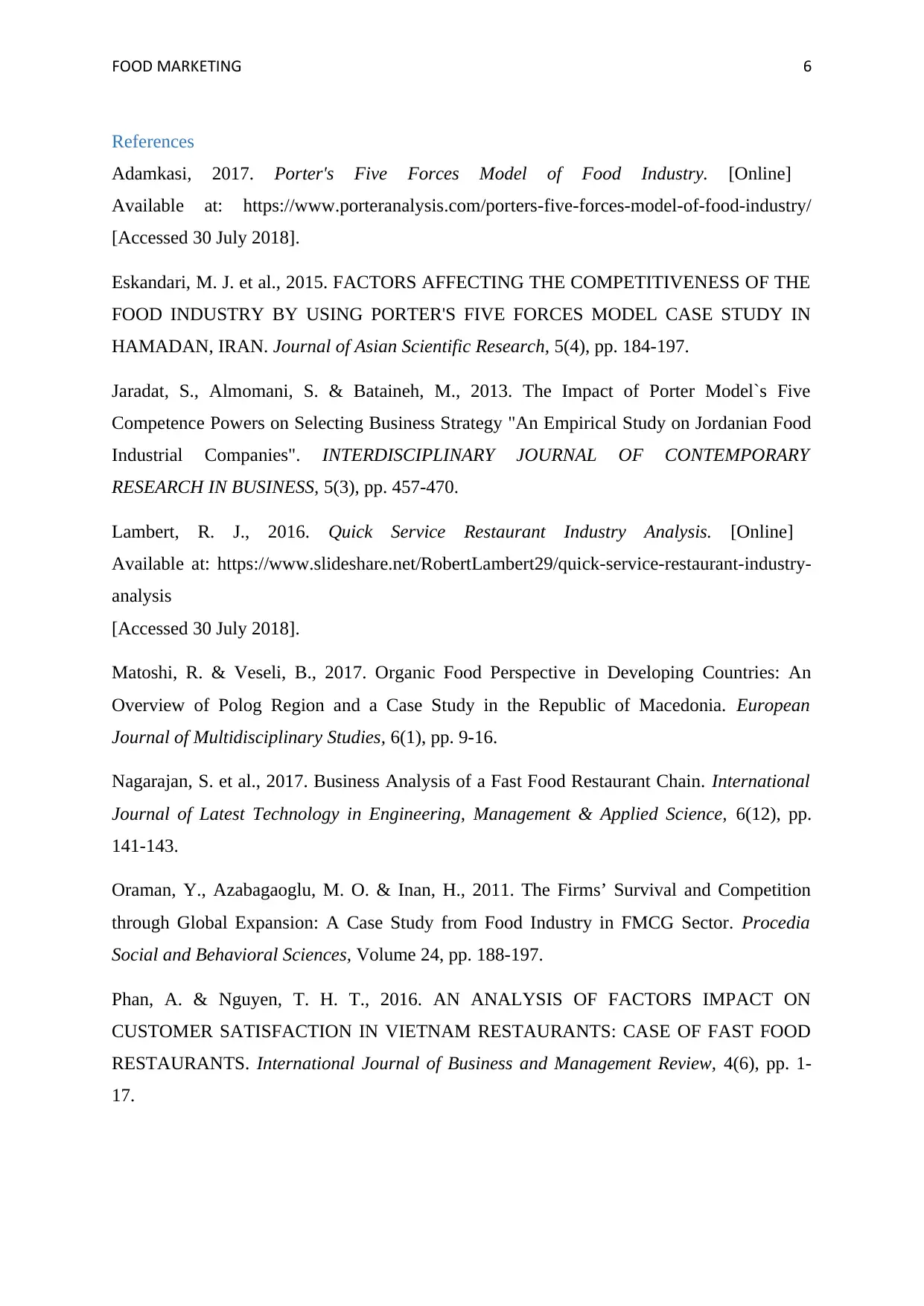
FOOD MARKETING 6
References
Adamkasi, 2017. Porter's Five Forces Model of Food Industry. [Online]
Available at: https://www.porteranalysis.com/porters-five-forces-model-of-food-industry/
[Accessed 30 July 2018].
Eskandari, M. J. et al., 2015. FACTORS AFFECTING THE COMPETITIVENESS OF THE
FOOD INDUSTRY BY USING PORTER'S FIVE FORCES MODEL CASE STUDY IN
HAMADAN, IRAN. Journal of Asian Scientific Research, 5(4), pp. 184-197.
Jaradat, S., Almomani, S. & Bataineh, M., 2013. The Impact of Porter Model`s Five
Competence Powers on Selecting Business Strategy "An Empirical Study on Jordanian Food
Industrial Companies". INTERDISCIPLINARY JOURNAL OF CONTEMPORARY
RESEARCH IN BUSINESS, 5(3), pp. 457-470.
Lambert, R. J., 2016. Quick Service Restaurant Industry Analysis. [Online]
Available at: https://www.slideshare.net/RobertLambert29/quick-service-restaurant-industry-
analysis
[Accessed 30 July 2018].
Matoshi, R. & Veseli, B., 2017. Organic Food Perspective in Developing Countries: An
Overview of Polog Region and a Case Study in the Republic of Macedonia. European
Journal of Multidisciplinary Studies, 6(1), pp. 9-16.
Nagarajan, S. et al., 2017. Business Analysis of a Fast Food Restaurant Chain. International
Journal of Latest Technology in Engineering, Management & Applied Science, 6(12), pp.
141-143.
Oraman, Y., Azabagaoglu, M. O. & Inan, H., 2011. The Firms’ Survival and Competition
through Global Expansion: A Case Study from Food Industry in FMCG Sector. Procedia
Social and Behavioral Sciences, Volume 24, pp. 188-197.
Phan, A. & Nguyen, T. H. T., 2016. AN ANALYSIS OF FACTORS IMPACT ON
CUSTOMER SATISFACTION IN VIETNAM RESTAURANTS: CASE OF FAST FOOD
RESTAURANTS. International Journal of Business and Management Review, 4(6), pp. 1-
17.
References
Adamkasi, 2017. Porter's Five Forces Model of Food Industry. [Online]
Available at: https://www.porteranalysis.com/porters-five-forces-model-of-food-industry/
[Accessed 30 July 2018].
Eskandari, M. J. et al., 2015. FACTORS AFFECTING THE COMPETITIVENESS OF THE
FOOD INDUSTRY BY USING PORTER'S FIVE FORCES MODEL CASE STUDY IN
HAMADAN, IRAN. Journal of Asian Scientific Research, 5(4), pp. 184-197.
Jaradat, S., Almomani, S. & Bataineh, M., 2013. The Impact of Porter Model`s Five
Competence Powers on Selecting Business Strategy "An Empirical Study on Jordanian Food
Industrial Companies". INTERDISCIPLINARY JOURNAL OF CONTEMPORARY
RESEARCH IN BUSINESS, 5(3), pp. 457-470.
Lambert, R. J., 2016. Quick Service Restaurant Industry Analysis. [Online]
Available at: https://www.slideshare.net/RobertLambert29/quick-service-restaurant-industry-
analysis
[Accessed 30 July 2018].
Matoshi, R. & Veseli, B., 2017. Organic Food Perspective in Developing Countries: An
Overview of Polog Region and a Case Study in the Republic of Macedonia. European
Journal of Multidisciplinary Studies, 6(1), pp. 9-16.
Nagarajan, S. et al., 2017. Business Analysis of a Fast Food Restaurant Chain. International
Journal of Latest Technology in Engineering, Management & Applied Science, 6(12), pp.
141-143.
Oraman, Y., Azabagaoglu, M. O. & Inan, H., 2011. The Firms’ Survival and Competition
through Global Expansion: A Case Study from Food Industry in FMCG Sector. Procedia
Social and Behavioral Sciences, Volume 24, pp. 188-197.
Phan, A. & Nguyen, T. H. T., 2016. AN ANALYSIS OF FACTORS IMPACT ON
CUSTOMER SATISFACTION IN VIETNAM RESTAURANTS: CASE OF FAST FOOD
RESTAURANTS. International Journal of Business and Management Review, 4(6), pp. 1-
17.
Paraphrase This Document
Need a fresh take? Get an instant paraphrase of this document with our AI Paraphraser

FOOD MARKETING 7
1 out of 8